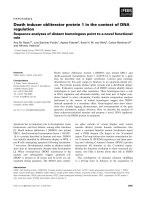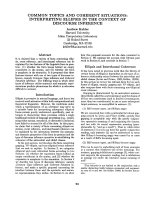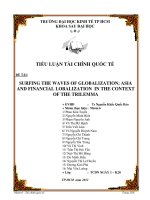Digital Transformation In The Context Of Vietnamese University Autonomy
Bạn đang xem bản rút gọn của tài liệu. Xem và tải ngay bản đầy đủ của tài liệu tại đây (753.29 KB, 10 trang )
DIGITAL TRANSFORMATION IN THE CONTEXT
OF VIETNAMESE UNIVERSITY AUTONOMY
Le Van Hinh
(University of Economics and Law)
Do Dinh Thai
(Sai Gon University)
Nguyen Van Y
(Ho Chi Minh Cadre Academy)
Abstract: The world is in the context of fourth industrial revolution. Many things are changing for the better.
So, Vietnamese higher education is obligated to change in response to the regional education developement.
Vietnamese universities have many conditions right now to develop in response to the demand of society. Among
those is the autonomy for Vietnamese university. The Vietnamese goverment in 2021 has issued articles related to
the digital transformtion and promoted the digital transformation.
In this article, we will introduce what the digital transformation is, how Vietnamese university development
benefits from the digital transformation and how the University of Economics and Law will implement the
digital transformation for training programmes, quality assurance and university governance and provide some
suggestions for higher education in Vietnam
.
Key words: Higher Education, University Autonomy, Digital transformation.
1. INTRODUCTION
With the explosion of the industrial revolution 4.0, the outstanding development of online-based
communication technology has been changing the academic environment and contributing to the digital
transformation at the institution. Today almost every student owns at least one smartphone and is able to
access the internet through this mobile device. The universities are increasingly interested in accepting
new media technologies in teaching and enhancing digital transformation in teaching.
The digital transformation specifically e-learning, during the COVID-19 pandemic, has been seen
as a backup education system to continue the learning process. To date, this disease COVID-19 has
broken out and spread almost all over the world. The inability to predict when this pandemic will end
and brings a lot of uncertainty and confusion affecting economic, social and political institutions, as well
as the connections between individuals.
In the context of the pandemic, studies (Youssef, AB, & Dahmani, M., 2008; Batista, J., Morais, S.,
& Ramos, F., 2016) have proven the digital transformation as a tool useful because of its ability to increase
the level of interaction between students and faculty in higher education. This type of interaction takes
place mainly in the classroom, but now it is not limited to just one place but can happen almost anywhere
and at any time (Wentzel, 2009). In addition, through online learning activities, students use mobile
devices to become more effective in their daily tasks and also in innovating their learning methods.
Students also become more self-sufficient due to easier access to available information. Instructors have
also changed the way they teach, taking advantage of greater access to information technology.
276
PROCEEDINGS OF 1 ST HANOI FORUM ON PEDAGOGICAL AND EDUCATIONAL SCIENCES
Thus, the application of technology in higher education is an essential need to respond to the rapid
change taking place in the world (Butt, BZ, & Ur Rehman, K., 2010). However, the digital transformation
in teaching requires readiness in many aspects, (Sabo, 2014) and argues that the human resources are
important keys because there may be cases where students establish communication with teachers any
time of the day or any day.
2. LITERATURE REVIEW
2.1. Legal documents
Actually, there are some misunderstandings about the digital transformation. Firstly, everything
should not be digital transformation in the framework of a university. Secondly, even once the technology
is applied, there is no guaranteeing the success of your company or university. The first step for the digital
transformation is the change of your mindset, strategy and vision of each institution like the image below:
Source: />
So, Vietnamese government has issued the decision number 2289/QĐ-TTg about the national strategy
for fourth industrial revolution and decision number 749/QD/TTg about the digital transformation. Those
legal reasons help Vietnamese universities build its development strategy, based on the two important
decision, and define the concrete coopeations between foreign universities and Vietnamese partners.
2.2. Definitions
2.2.1. The definition of Christ of Ebert and Carlos Henrique C. Duarte, IEEE (2018) introduced digital
transformation goals about the social goals and economic goals in which the role of the technology is
less important than the knowledge of the people.
Digital Transformation Goals
Perspective
Objectives
Foster the development of a more innovative and collaborative culture in industry and society
Change the education system to provide new skill and future orientation to persons so that they
can achieve excellence in digital work and society
Social
Create and maintain digital communication infrastructure and ensure their governancem
accessibility, quality of service and affordability
Strenthen digital data protection, transparency, autonomy and trust
Improve the accessibility and quality of digital services offered to the population
section 2: education and educational management in the context...
Economic
277
Implement new and innovative business models
Increase income generation productivity and value addition in economy
Improve the regulatory framework and technical standards
2.2.2. Digital: recording or storing information as a series of the numbers 1 and 0, to show that
a signal is present or absent1.
2.2.3. Transformation: a complete change in the appearance or character of something or someone,
especially so that thing or person is improved2
2.2.4. Strategy:a detailed plan for achieving success in situations such as war, politics, business, industry,
or sport, or the skill of planning for such situations3
3. RESEARCH METHOD
Rodrigruez-Abitia, G.; Bribiesca-Correa, G, (2021), the digital transformation takes place on 3
aspects: (1) ICT application at the universities, (2) materials and methods and (3) results and discussions;
Oleg Ye. Kaminskyi, Yulia O. Yereshko và Sergii O. Kyrychenko (2018), the digital transformations
is set to digitize all major, all services to the learners (university admission, the choice of curricula and
courses, the results of examinations, etc.…), curriculum, financial management, training planning, academic
training scheduling and many other functions. The university, as a provider of educational services, should
first focus on creating new services and and converting existing services into digital ones. Here is the
model for the digital transformation at the university.
Source: Oleg Ye. Kaminskyi, Yulia O. Yereshko and Sergii O. Kyrychenko (2018)
1 Retrieved from />2 Retrieved from: />3 Retrieved from />
278
PROCEEDINGS OF 1 ST HANOI FORUM ON PEDAGOGICAL AND EDUCATIONAL SCIENCES
Those are two research model from the foreigner universities about the digital transformation.
Our research is based on the use of general scientific and theoretical methods: analysis and synthesis
of scientific, technical and pedagogical literature concerning the digital transformation of society and
its impact on the system of higher education; studying digital transformation at the University of
Economics and Law; making an assessment, evaluating the good aspects and disadvantages of digital
transformation the combination of theories and conclusions from various fields of research. The paper
uses argumentative, deductive, inductive and systematic approaches.
4. THE DIGITAL TRANSFORMATION IN THE CONTEXT OF VIETNAMESE HIGHER EDUCATION
On December 9th, 2020, the workshop on “Digital transformation in education and training”,
Minister of Education and Training, Phung Xuan Nha said: “In June 2020, the Prime Minister approved
the National Digital Transformation Program to 2025 oriented to 2030 in which education and training
is one of the top eight priority areas” and he affirmed “The education sector focused on training
Vietnamese citizens with knowledge and skills about the digital transformation to become global
citizens. Therefore, the digital transformation is identified as a breakthrough and an important task that
needs to be implemented in the coming years. The implementation of digital transformation not only
helps improve the quality of education, but more importantly contribute to improving labor productivity,
creating great opportunities for international integration.
The Minister sets out the orientation of digital transformation in education in general and in higher
education in particular: “First of all, there should have a unified national technology foundation for each
collective and individual, every teacher, every student who can participate and function effectively.
Based on that foundation, it will continue to perfect the database, build a repository of digital learning
resources in which management, learning, research, teaching, and knowledge sharing activities become
effective and practical”.
We can understand the digital transformation is inevitable, especially in the context of the fourth
industrial revolution which has been developing strongly. The digital transformation is a long process, the
result of this process can bring a new look of education, many new methods, tools and so on... The digital
transformation orientation of Vietnamese higher education begins firstly with the awareness of leaders,
lecturers and students and needs to focus on two directions: Firstly is the application of technology in
teaching and learning, scientific examination, evaluation and research and secondly is the application of
technology in educational management.
The digital transformation takes place on 3 core fields in Vietnam Higher Education
a. Application of technology in teaching, learning, testing, assessment and scientific research
With the development of technology, almost all aspects of teaching and learning can be using
technology. The most typical is the transition from teaching on a blackboard with white chalk into
beautiful, clear digital lectures that are convenient for both learners and teachers. In Vietnam, according
to ViOLET’s statistics, there have been nearly one million electronic lectures uploaded by the teaching
and learning community. This is a rather big number which demonstrates the growth rate in transforming
teaching and learning models, as well as the potential and demand of digital transformation in teaching
and learning.
Online teaching always goes along with the development of digital learning materials, and
at the same time it is necessary to build a healthy and convenient digital learning environment for
section 2: education and educational management in the context...
279
both teachers and learners. In addition, human resources, mainly lecturers, also need to be flexible
in teaching, especially need to improve their qualifications and adapt to the digital transformation
in higher education in particular and the industry revolution 4.0 in general. Therefore, at the higher
education online conference, Deputy Minister of Education and Training – Mr. Hoang Minh Son, the
digital transformation at the higher education focused on a number of key orientations: “Development
of the grassroots system national data on higher education; Developing and exploiting learning materials
platforms and digital learning environments; Developing highly qualified human resources for national
digital transformation”.
When the digital transformation takes place, the examination and assessment of education quality
should be considered because the teaching and learning model have changed, it is necessary to change
the way of testing and assessment to adapt in the new context. Many universities have developed
regulations to assess the quality of education for online teaching. The advantage of assessing an online
test helps student know their result immediately in comparison with the traditional test. The assessing
can be made many times, anywhere. In addition, the teachers can easily monitor the learning progress of
each student, adjust and shape the teaching methods in the best way.
The digital transformation in higher education has a great influence on the scientific research
process of both faculty and students. By sharing a common data set and scientific research results among
member universities will promote the scientific research process at each educational institution. In
addition, when the digital transformation process takes place, opportunities for international cooperation
between universities are also enhanced, raising the level of university lecturers.
Last but not least, the application of digital transformation in higher education will contribute to
promoting the development of subjects or training programs of the future such as artificial intelligence
(AI), data science, data analysis, big data…etc. Thereby, both teachers and learners need to have the
necessary skills to keep up with the development trend of the times. Even managers need to invest in
equipment, effort, and necessary funds to catch up with this “new wave”.
b. Application of technology in educational management
Deputy Minister of Education and Training Hoang Minh Son said in the higher education online
conference: “In 2007, credit training which was launched in a few schools allow learners to register for
study and to view their learning results and pay tuition fees online. Most universities have implemented
this kind of training today. The registration for high school exams and online admission, school
administration are also digitized and implemented on the basis of information technology application”.
This not only helps to reduce the workload in management, but also helps to improve the quality of
educational management, promote the model more simple, more effective than traditional models.
Specifically, the digital transformation in educational management includes the digitization of
information which is necessary to establish large interconnected databases, and uses the achievements
of 4.0 technology to manage, forecast, operate and make decision accurately and quickly.
Currently, according to statistics, the electronic management system of more than 300 universities
and colleges across the country has operated stably, smoothly and associated with the development of
technology platforms.
280
PROCEEDINGS OF 1 ST HANOI FORUM ON PEDAGOGICAL AND EDUCATIONAL SCIENCES
c. Development strategy of higher education institutions in Vietnam towards autonomy in the
context of digital transformation
The introduction of Law No. 34/2018/QH14 and Decree 99/2019/ND-CP has promoted the process
of university autonomy. In the context of digital transformation, the process of university autonomy also
needs many changes to adapt to new circumstances and improve the quality of the training institution
itself in particular and of higher education in particular.
Currently, the university autonomy model is born under the management of the university council.
The members of university council are very diverse in many universities including businessmen. This is
the foundation of the development for digital transformation in the trend of university autonomy.
The role and function of the university council were formed. We can see that the digital transformation
will help the university council to properly implement the autonomy model
5. Actual digital transformation at the University of Economics and Law
In order to have a good model for Vietnamese university autonomy, Vietnamese Goverment has
issued the legal document: Decree 77/2017 about the piloting model of operating mechanism with public
higher education institutions in the period 2014-2017 (Accoding to the decision, there are 23 public
higher education institutions) which allows public higher education institutions to increase the tuitition
fee to improve the education quality in the new context of Vietnamese autonomy university.
Learners in the digital era are learners who want to create value and product-oriented learning
(Zhao, 2012). They co-create teaching content with the teacher and with the university. Their position
move from a receiving position to a provider position. The lecturer no longer plays the role of providing
knowledge, but also creates a customized learning context according to the learners’ requirements.
At the same time, ICT has changed the teaching, learning and research environment of universities
which have to reshape teaching because the teaching activities is no longer within the framework of the
university. ICT changes the services for academic training activities, scientific research of universities.
In that context, the application of the digital transformation at UEL is imperative to meet the new
requirements of learners, employers and stakeholders, help learners co-create teaching content. in the context
of university autonomy of Vietnamese universities.
The University of Economics and Law, Vietnam National University Ho Chi Minh City (UEL) has
implemented the university autonomy at the beginning of 2021 which allows to increase the tuitition fee,
to improve the education quality in the new context of Vietnamese autonomy university. The autonomy
university falicitated UEL to develop in term of training, the scientific activities, the finance activities, the
human ressources, the academic activities, to build its brands, to to improve the education quality, has
made breakthroughs in training and research, contributing to creating a new “face” for higher education
system of Vietnam.
The digital transformation of UEL in the fields of economics, law and management is a mandatory
condition to develop itself in all aspects, to best meet the needs of learners and stakeholders. The digital
transformation helps the university operate well the human resources, finance, training and research aspects
for the faculties, the supporting departments as well as the university’s research units in the new context.
So, UEL assess that digital transformation is vital for its developement in the context of 4th Industrial
Revolution and university autonomy. In UEL’s strategy, the digital transformation is one of the 3 pillars
section 2: education and educational management in the context...
281
for the new development. UEL also implements the E-learning on different platformes BigBlueButton
(BBB), Zoom, Quickcom or Google Meet to support students. Moreover, UEL has constructed digital
learning materials in the framework of Education 4.0 Project.
Here is some aspects of the digital transformation at the UEL.
5.1. E-learning
No
Year
Faculty
2016
2017
2018
2019
2020
Electronic commerce
57
106
115
123
113
Management Information System
71
98
106
108
99
-
-
-
-
39
-
-
33
71
109
Faculty of Information System
Number of student
1.
Digital business and artificial intelligence
2
Faculty of Economics Maths
Applied mathematics in economics, management and finance
Source: UEL
5.2. Some information about the Education 4.0 Projet
No
Faculty
Year/ Number of subject
(including slide, case study,
e-test, introduction video)
Subject
1. E-marketing
2. System analysis and design
2018
6 subjects for online material
3. Programming techniques
4. Business website design and
programming 1
5. Data Analytics in Business
6. Data structure
1
Faculty of Information
System (20)
1. Basics Informatics
2019
6 subjects for online material
2. Business Information System
3. Management information systems
4. E-commerce
1. Information system technology platform
2020
4 subjects for online material
2. Graphics and multimedia
3. Database management system
4. Information system security
282
PROCEEDINGS OF 1 ST HANOI FORUM ON PEDAGOGICAL AND EDUCATIONAL SCIENCES
1. Applied Statistics
2. Econometric
2021
06 subjects for online material
3. Economic forecasting
4. Time series analysis in finance
5. Asset Valuation Model
6. Operations Research
2018: 03 subjects for online
material
2019: 3 subjects for online
material
2
Faculty of Economics
Maths (11)
1. Applied Statistics
2. Econometric
3. Economic forecasting
1. Higher Mathematics
2. Bayesian Statistics
3. Data Visualization
1. Probability theory
2020: 3 subjects for online
material
2021: 02 subjects for online
material
2. Maths for Economics
3. Time series analysis in finance
1. Asset Valuation Model
2. Operations Research
Source: UEL
In the academic year 2019 – 2020, there were 1.751 subjects and in 2020 – 2021, there were 1969
subjects which are implemented in the framework of Education 4.0 Project. The UEL took many steps
to prepare for the digital transformation and has received many positive feedbacks from the faculties
and students after 2 years. Moreover, the digital transformation will be better if the infrastructure for IT,
e-learning and the most important things are improved more and more.
5.3. Advantages and disadvantages of the digital transformation at the University of Economics
and Law
5.3.1. Advantages:
- The active participations of the rectorate board, all faculties and departments
- The experiences in developing training programs according to CDIO in the period 2015 - 2017;
- The implementation of the Education 4.0 Project for the period 2018 - 2022 setting up a good
environment for E-learning teaching at the university.
- The active participation of students according to the blended learning teaching method.
5.3.2. Disadvantages:
- The trainers meet the difficulties due to the schedule and COVID-19.
- The regulations of IT application for training management and organisation takes time because it
relates to the finance, properties industries and legal documents.
5.3.3. Some suggestions for the university autonomy in the context of the digital transformation
• Start the changes from the leader’s mindset, university council. It is necessary to manage university
activities by applying available technologies on the basis of a common database of universities.
section 2: education and educational management in the context...
283
• There should have a set of evaluation rules, measuring work performance based on KPIs and
implement through scientific research evaluation indicators such as h-index, Citations, or i-10 index.
This contributes to international integration about the research in particular and to the development of
higher education in general.
• In the context of university autonomy, financial autonomy can be implemented with student data
which gives recommendations for admissions activities in order to have a roadmap to attract students.
• Organize more academic activities through online seminars which contributes to promoting the
development of local human resources and, at the same time, to attracting foreign investment.
• There should have an examination and evaluation of the effectiveness of autonomous activities in
higher education. This can be done by application of verified inspection systems and implemented in parallel
with personal assessments to avoid subjective assessments which waste finance and human resources.
• Encourage students and lecturers to seek out open learning resources and online courses to
improve their qualifications, thereby universities’ leaders build a suitable e-learning system for their
own higher education institution: like Coursera, Udemy, Edx,...
• Train the human resources (managers, lecturers, specialists, students) with knowledge and skills
to meet digital transformation requirements: skills in using IT, skills in information security, skills in
exploiting and using applications for teaching and learning work.
• Finally, strengthen the link between the school and the business in order to meet the student’s
output in response to the needs of the employer. They can have the opportunities to use the new
technology instead of using the outdated technology at the university.
6. CONCLUSION
Digital transformation is not just about disruption or technology. It’s about value, people,
optimization and the capability to rapidly adapt when needed through an intelligent use of technology
and information. It is the profound transformation of business and organizational activities, processes,
competencies and models to fully leverage the changes and opportunities of a mix of digital technologies
and their accelerating impact across society in a strategic and prioritized way, with present and future
shifts in mind.
The Vietnamese universities should implement digital transformation in the new context, which
helps them develop, intergrate to internationalisation, save money, adapt to learner’s demand. The first
step should start from the strategy of each university and change mindset and attitude from the leaders,
each person at the institution which are the core elements for digital transformation. That is the biggest
transformation for the university autonomy in Vietnam Higher Education.
REFERENCES
1.
Batista, J., Morais, S., & Ramos, F. (2016). Researching the Use of Communication Technologies
in Higher Education Institutions in Portugal. In Handbook of Research on Engaging Digital
Natives in Higher Education Settings. IGI Global. pp. 280-303,
2.
Butt, B. Z., & Ur Rehman, K. (2010). A study examining the students satisfaction in higher
education. Procedia-Social and Behavioral Sciences, 2(2), 5446-5450,
284
PROCEEDINGS OF 1 ST HANOI FORUM ON PEDAGOGICAL AND EDUCATIONAL SCIENCES
3.
Christ of Ebert and Carlos Henrique C. Duarte. (2016) Requirements Engeeneering for the
Digital transformation: An Industry Panel, Proc. 24th IEEE Int’l Requirement Eng. Conf. (RE
16), pp. 4 – 5,
4.
Oleg Ye. Kaminskyi, Yulia O. Yereshko và Sergii O. Kyrychenko (2018), Digital Transformation
of University Education in Ukraine: Trajectoire of Development in the Conditons of New
Technological and Economic Order. ISSN: 2076-8184. Information Technologies and Learning
Tools, 2018, Vol 64, №2,
5.
Rodríguez-Abitia, G.; Bribiesca-Correa, G. (2021) Assessing Digital Transformation in
Universities. Future Internet 2021, 13,
6.
Sabo, R. (2014). How technology is changing how teachers communicate with students in teach
thought. Retrieved from />
7.
Zhao, Y. (2012). World class learners: Educating creative and entrepreneurial students (1st ed.).
Thousand Oaks, CA: Corwin,
8.
Youssef, A. B., & Dahmani, M. (2008). The impact of ICT on student performance in higher
education: Direct effects, indirect effects and organisational change. RUSC: Universities and
Knowledge Society Journal, 5(1), 45-56.
9.
/>
10.
/>
11.
12.
13.
/>
14.
/>
15.
/>









